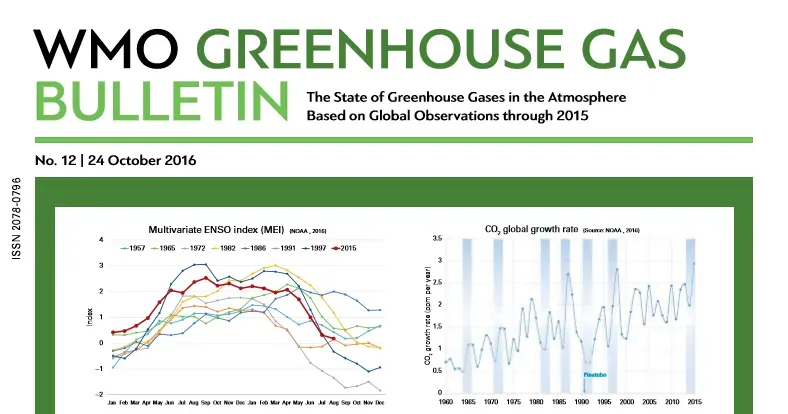About Greenhouse Gas Bulletin:
- It has been published annually since 2004 by the World Meteorological Organization.
- It shows globally averaged surface mole fractions for carbon dioxide (CO2), methane (CH4) and nitrous oxide (N2O) and compares them with the mole fractions during the previous year and with preindustrial levels.
- It also provides insights into the change in radiative forcing by long-lived GHGs (LLGHGs) and the contribution of individual gases to this increase.
- It is one of WMO’s flagship publications released to inform the UN Climate Change conference (COP).
Highlights of the Bulletin
- The globally averaged surface concentration of carbon dioxide reached 420 parts per million (ppm), methane 1934 parts per billion and nitrous oxide 336.9 parts per billion (ppb) in 2023.
- Carbon dioxide is the single most important greenhouse gas in the atmosphere related to human activities, accounting for approximately 64 per cent of the warming effect on the climate, mainly because of fossil fuel combustion and cement production,
- The long-term carbon dioxide increase is due to fossil fuel combustion, but there are year-to-year variations due to the El Nino–Southern Oscillation, which impacts photosynthetic carbon dioxide uptake, respiratory release, and fires.
- Methane is a powerful greenhouse gas which remains in the atmosphere for about a decade. Methane accounts for about 16 per cent of the warming effect of long-lived greenhouse gases.
- Nitrous oxide, an ozone depleting chemical, accounts for about 6 per cent of the radiative forcing – the warming effect on the climate — by long-lived greenhouse gases.
- From 1990 to 2023, radiative forcing — the warming effect on our climate — by long-lived greenhouse gases increased by 51.5%, with CO2 accounting for about 81 per cent of this increase.
Q1: What is the World Meteorological Organization?
It is a specialized agency of the United Nations (UN). It was established in 1950, WMO became the specialized agency of the UN for meteorology (weather and climate), operational hydrology and related geophysical sciences.
News: With 11% increase over 2 decades, carbon dioxide accumulates faster in atmosphere
Last updated on June, 2025
→ UPSC Notification 2025 was released on 22nd January 2025.
→ UPSC Prelims Result 2025 is out now for the CSE held on 25 May 2025.
→ UPSC Prelims Question Paper 2025 and Unofficial Prelims Answer Key 2025 are available now.
→ UPSC Calendar 2026 is released on 15th May, 2025.
→ The UPSC Vacancy 2025 were released 1129, out of which 979 were for UPSC CSE and remaining 150 are for UPSC IFoS.
→ UPSC Mains 2025 will be conducted on 22nd August 2025.
→ UPSC Prelims 2026 will be conducted on 24th May, 2026 & UPSC Mains 2026 will be conducted on 21st August 2026.
→ The UPSC Selection Process is of 3 stages-Prelims, Mains and Interview.
→ UPSC Result 2024 is released with latest UPSC Marksheet 2024. Check Now!
→ UPSC Toppers List 2024 is released now. Shakti Dubey is UPSC AIR 1 2024 Topper.
→ Also check Best IAS Coaching in Delhi
























